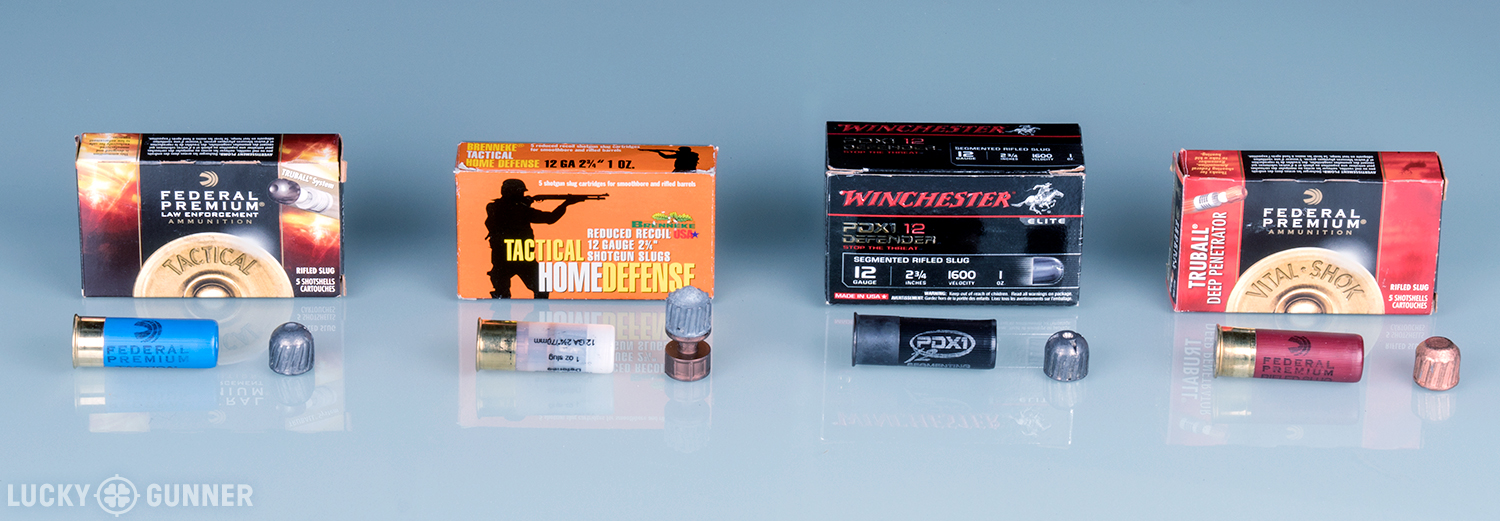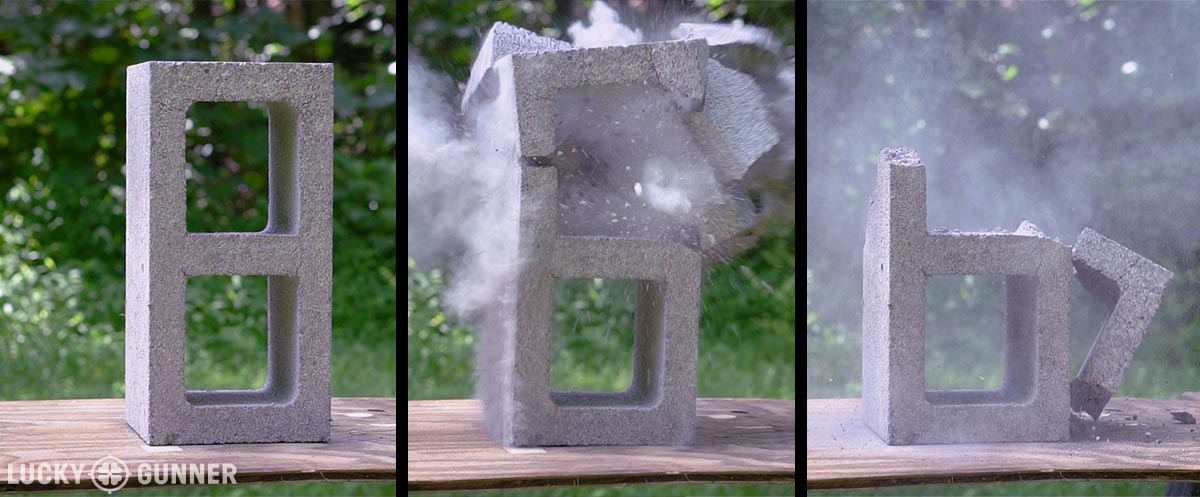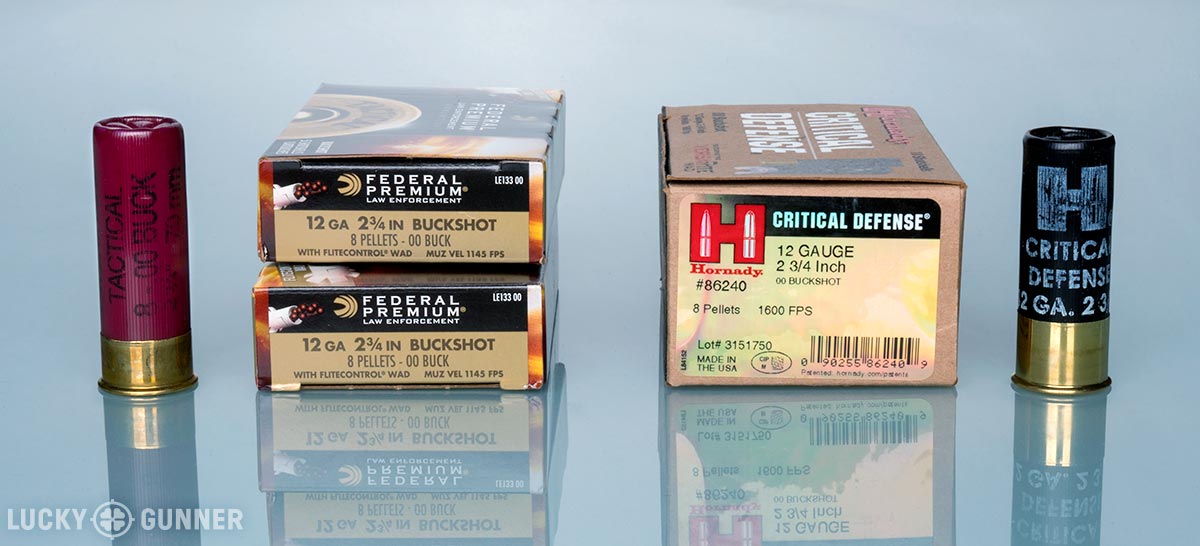For anyone interested in using a shotgun as part of their home defense plan, I typically recommend loading that shotgun with buckshot. A lot of people have asked about using slugs as an alternative, or maybe keeping a couple of slugs handy on a sidesaddle to complement the buckshot. So today I’m going to take a look at the shotgun slug and whether it might have a place in the context of home defense.
Watch the video below for more, or scroll down and keep reading for the transcript.
There are a number of different types of slugs but generally speaking, a shotgun slug is a shell that fires one big projectile instead of a bunch of smaller ones like birdshot or buckshot. Slugs are really useful if we need to extend the range of the shotgun or in situations where penetration is really important. 00 buckshot is the most common type of defensive shotgun ammo and it’s very effective up to about 25 yards. With a tight pattern, you can maybe stretch it out to 40 or 50. Beyond that, there are much better options.

A slug will extend the shotgun’s range to at least 75 or 100 yards. In situations where a rifle would be the ideal tool, but for whatever reason a shotgun is what you have instead, slugs can essentially turn that shotgun into a limited-range rifle. So if you think of your shotgun as a defensive tool you might use both inside and outside your home, like if you have a large property to take care of, having the option to use slugs might make sense.
If we need to punch through a barrier, a 12 gauge slug is one of the best tools we have available. This is really useful for law enforcement, because they often have to fight in and around cars, and a slug will penetrate right through a car body or windshield far more consistently than buckshot, or a handgun or a carbine.
Let’s bring it back to the context of personal protection for the average armed civilian. The shotgun is most commonly stored in the home, and its intended use is limited to, essentially, hallway distances. Unless you live in a very large house, I don’t think a slug offers any advantage over buckshot in that context. Buckshot is made specifically for short-range encounters like these. You need to stop somebody right now at very close range, and buckshot lets you shoot them 8 or 9 times with one press of the trigger. We don’t need the range or the penetration of the slug inside a home, and in fact, that can work against us.
Whether or not a slug hits the intended target, it can travel really far and go through a lot of stuff before it stops. It’s a huge liability because of its potential to sail through exterior walls and still have plenty of energy left over to kill somebody. Now, there are no magic bullets. Any projectile you can fire through a shotgun, rifle, or pistol that can physically disable an attacker will also penetrate through a couple of pieces of drywall or plywood. There’s no getting around that — interior wall penetration, in particular, is something we have to consider with any firearm or ammunition, a topic that Spencer explored a few weeks ago in this article. But the penetration of a slug is on a whole different level. We’re not only concerned about somebody who might be in another bedroom, but we could also be putting the whole neighborhood at risk.

Of course, buckshot also carries a risk of hitting unintended targets, not as much because of over-penetration, but because of the spread of the shot. I wouldn’t worry too much about having to take that tactical fantasy camp type hostage shot where the bad guy is ducking behind your family member and you can only see their eyeball. But it’s not unheard of for an armed citizen to be faced with a threat who is already in some kind of physical altercation with a family member. It might be a shot you’re confident you can make, but not if you’re worried about a stray pellet hitting the wrong person.
This is just one reason it’s really important to pattern the shotgun with our intended home defense load ahead of time. All that means is that we go to the range and shoot at a target to see what the spread looks like at various distances that match the distances inside our home. This is something you really have to do yourself because each individual shotgun barrel is a little different and no two guns are guaranteed to pattern the same way with a particular load.
You can probably find several loads that won’t spread much at all within typical home-defense distances, but if you want to minimize that spread there’s a little shortcut. Federal FliteControl and Hornady Critical Defense 00 buckshot are both made with a special wad that holds the pellets together after they exit the barrel, so with almost any gun, you will get a single 2 or 3-inch wide hole in the target at any distance up to about 10 yards — that’s 30 feet. If you think about the inside of your home, there probably aren’t many places where you’d have to take a shot longer than that. I have personally had better luck with getting tight patterns out of the 8 pellet version of the Federal FliteControl load compared to the Hornady buckshot, but you may get different results with your shotgun.
So even without a slug that can possibly exit our house at lethal velocities, the shotgun can still be used to make a precision shot at close range if necessary. Choosing the right buckshot load gives us the ability to quickly stop a threat in the home without endangering anyone else.
If you liked this article, be sure to check out the rest of our defensive shotgun series!




I have plenty of slug loads – but I roll my own for the special ones. Flechette’s, Reduced slug loads, .50 caliber sabot..
I like chris bakers articles and vids.the guy makes sense and spares us from the high and mighty I know everything about guns and ammo type.
Yup. Totally agree.
Me too. He’s one of only a few that I really look forward to reading.
Thank you for an informative article that describes the pros and cons of both buckshot and slugs. But I get the best of both worlds by loading my home-defense Brown Bess with buck and ball. Then if I miss, I can retreat behind the smokescreen.
I always look forward to the Lucky Gunner articles. Real World commentary based upon knowledge and experience. Thank You!
As much as I enjoy my handguns; it’s hard to beat a shorty shotgun for HD. I load my 18″ Mossy which has a Shockwave grip and TLR-4 laser/light for very tight tactical maneuverability with Fiocchi’s reduced recoil ’00’. IMHO…8 pellets at 1150fps is plenty for inside the home. Equivalent to 8 32 caliber bullets in one blast.Patterns well at HD range of 5-10yds. The Remington LE reduced-recoil with 8 pellets at 1200fps is just a tad hotter. I also use the Federal LE 132 00 or LE 133 #1Buck that patterns like a slug out to 10 yards and then just begins to open up. I usually load so the Federals are my last 2 shells. A 1″ hole at close range bleeds out quickly, but the pellets won’t travel far like a slug.
I’m with you here on the great real-world writing. These writers at Lucky Gunner Lounge are really good and I always look forward to reading their articles.
I also use the same Remington and Federal loads you mention. I am certain (been to the leading trainers) it’s advised by several of the leading trainers to not load different round types in the magazine tube. In a defensive situation you won’t have the luxury of being able to reason which rounds are in which position. It’s the same reasoning/training to not stagger the loading of FMJ and hollow points in a defensive handgun. Just load all hollow points, if you want barrier penetration then get bonded hollow points.
It’s best to learn how to perform change-overs. For instance, load the magazine with all buckshot and have one or more slugs in a sidesaddle or buttstock cuff, then do a select-slug changeover. You are already using Federal loads with the Flitecontrol wads and that will make a pattern about the size of two slug widths at 10 yards from a cylinder bore barrel. Select slug change-overs are quite easy when the gun starts in the cruiser ready state or after one or more rounds of buckshot have been fired.
Train to run the gun like a professional instead of stacking different types of ammo for some imaginary what-if. When you have to run the gun for all of the marbles you will forget everything and fall back to your level of training. The ancient Art of the Dynamic Shotgun videos with Travis Haley and Chris Costa are amazingly well-done and provide excellent training on pump and semi-auto shotguns. Train at the best training institutions in the country and you will be trained like you see in the videos.
This whole article appears to be dedicated to describing why slugs should not be your choice of defensive shotgun loads for home defense.
Dazor, I agree with you about not staggering different rounds in a handgun. Stay with one ammo that works best for the task and that brings the muzzle back on target consistently.
My Mossy 18″ 590 holds 6+1. It’s hard to imagine a Home Defense scenario where I’d need more than 3 or 4 shells. I can rack ’em off pretty quickly and at close range it’s devastating so the last few shells will probably not be needed no matter what they are. Doubtful I’d ever need to reload (or have time to) but I suppose a sidesaddle is a confidence-builder. However, I have heard that if the shotgun will remain loaded and sitting ready (in a bedside quick-access safe) for many months, it might be best to not load the magazine to the max to prevent the tightened spring taking a set and not feeding properly. So even if I load one less shell, I’ve still got 6 shots.
The sidesaddle on a home defense gun falls into the category “better to have it and not need it than need it and not have it.” That one less round in the magazine when you store the gun bedside is space for an immediate select slug change-over from the cruiser ready state. If stored bedside with the action open, combat load from the sidesaddle to the chamber. If stored bedside with the action closed, load the slug to the magazine tube because you have one space available and rack the slide.
Folks that live on the far outskirts of town on large lots or on farms may have a different need for slugs because of distances and the need for protection from both 2-legged and 4-legged predators. Urban and suburban dwellers are just fine with buckshot and like you said, probably won’t need more than 3 or 4 shells.
Make the magazine spring a non-issue by replacing the $4-$6 spring every 6 months whether it needs it or not. The price of the spring is less than one soda pop at a college or professional football or baseball stadium.
Dazor, Good suggestions; and especially for those living in bear country; an option I hadn’t considered.
lol! My barrier buster reduces a cinderblock into two piles. sand, and portland cement.
Two questions as a novice:
1-Can you switch between shot and slugs using the same barrel? I thought you needed to change barrels.
2-If the pellets stay together using those special rounds you mention, wouldn’t they have the same energy to shatter a cinder block?
I’m a novice too but I’ll give your questions a shot (pun intended):
#1- If your shotgun barrel is smooth or non-rifled, then you can fire buckshot or slugs although slugs made for rifled barrels will probably perform poorly in non-rifled barrels. If your shotgun barrel has rifling or twists like a rifle, then it can fire slugs of any kind and even buckshot although I think the rifling of the barrel will produce strange buckshot patterns.
#2- Shotgun rounds like Federal Flitecontrol hold the pattern tight until it hits something solid and then the pattern will open up. You’re going to get more penetration with a slug round than buckshot. At close range I suspect a 12 Gauge shotgun slug or 00 Buckshot round would do a number on a single cinder block with both penetrating although the slug round would have more energy left.
If I’m hopelessly off, someone please let me know 🙂
Foster slugs run well in smooth bore Shotguns.
If you’re using slugs or buckshot, you should use a cylinder bore (no choke) barrel. If you’re using birdshot for hunting, you may want an improved or full choke barrel to tighten your pattern at longer distances. That’s probably where the “two barrels” advice comes from.
Using rifled slugs in a smoothbore barrel is acceptably accurate; I’ve shot bowling pins at 50 yards with slugs from a smoothbore barrel. A rifled barrel may help accuracy with slugs, but it can screw up your pattern with shot so your pattern has a big hole in the middle (no hits) and looks like a doughnut.
If I were using a shotgun strictly for self-defense, I’d stick with an 18-inch (the shortest legal length), smoothbore barrel with a cylinder bore. If I were to use the same gun for hunting, I’d get an extra, longer barrel with a choke.
I haven’t done this for many years but it might be helpful. My shotgun with a 20′ bbl and rifle sights will make one large hole at 50 yards with 5 rifled slugs. It does this with any brand I’ve used. 00 buckshot would not print on the target board (2′ x 3′) at that range. I mean I never got one hole. The absolute maximum for 00 buck was 40 yards and I was not too happy with the spread. I consider 30 yards about max range for 00!
I have been unable to find any buckshot in 16-gauge, so am considering using slugs for home defense purposes; I have found 16-gauge slugs. QUESTION – is anyone aware of a source for 16-guage buckshot? Thanks.
I load my HD shot gun alternating 00buck and frangible boar slugs.
I’m repurposing a Mossberg 500a into a HDS. I had to talk to the shotgun range guys up at the clubhouse and found out I owned a gobbler gun and was schooled on chokes. I now have an improved cylinder choke on order. Then I’ll be able to use 00 and slugs. The HDS info on the Lucky Gunner site has been a huge help.